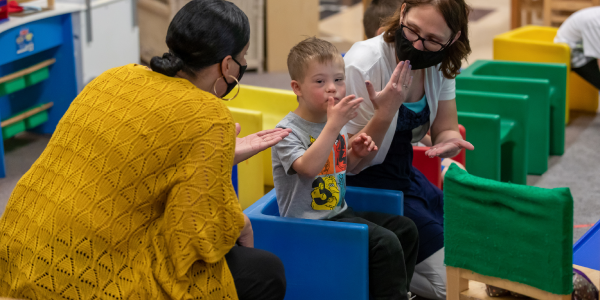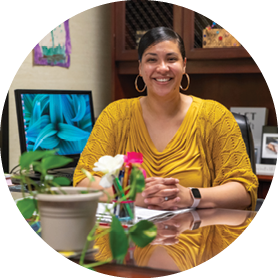Feature Program: Culver Family Learning Center

You are here
Culver Family Learning Center is one of 12 NAEYC-accredited early learning sites owned and operated by the Evansville Vanderburgh School Corp. (EVSC) in Indiana. It is the largest of the sites and serves as a hub for early learning in this public school district. Services at Culver are funded using Title I, On My Way Pre-K (Indiana’s state pre-K program), and special education funds (both state and federal). The program serves a diverse population of nearly 700 children, including children with disabilities, English-language learners (including a Spanish/English bilingual classroom), and children whose families are experiencing challenges. The program has operated for more than 10 years. Davida Johnson is the on-site director.
Why did your program decide to become NAEYC accredited?
Culver Family Learning Center is committed to providing the highest quality early learning possible. NAEYC accreditation represents the highest level of excellence for early learning nationally. Accreditation provides a shared perspective of the quality Culver strives for. Accreditation also provides a common set of expectations for staff, children, and families. The Indiana Office of Early Childhood and Out of School Learning recognizes NAEYC accreditation and provides additional funding to programs that have achieved it.
How has the accreditation process or being NAEYC accredited helped your program?
In Indiana, NAEYC accreditation affords us the opportunity to access additional funding to assist in meeting high-quality standards. It gives Culver a set of shared standards for accountability on which to build continuous improvement. While working on accreditation portfolios, teachers had the opportunity to hold each other accountable and to learn from each other. Each teacher had different interpretations of the standards; hence, they helped one another gain new perspectives. Culver has been accredited for 10 years. When talking with parents, we discuss the program’s accreditation. It guides parents on what to look for in high-quality early learning programs. It deepens families’ and teachers’ understanding of how children learn.
 What is a NAEYC program standard that your program has been especially focused on recently?
What is a NAEYC program standard that your program has been especially focused on recently?
Standard 4: Assessment of Child Progress; 4A: Creating an assessment plan. In addition to screening upon enrollment and with an ongoing assessment, Culver works with special education professionals, school psychologists with specialized training in early childhood, and social and emotional learning coaches—who are collectively called the Child Success Team (CST)—to implement a tiered intervention approach (Response to Intervention model, or RTI). Through this approach, children who may need additional supports receive interventions, and educators use formative assessments to monitor children’s progress over time. The process has been shown to help children and educators focus on specific goals and the sustained and individualized supports that will help children reach those goals.
How does your program connect with families and the community?
Connecting with families is critical for a number of reasons. Building a relationship with each family empowers them and builds trust. Teachers connect with children and families through home visits, family conferences, and multiple streams of communication, including social media, newsletters, personal notes, and phone calls. Culver conducts family engagement opportunities such as Expressive Arts Night, Family Movie Night, and Friendship Dances. Culver also conducts family nights in Spanish so our Spanish-speaking families receive information in their home language. Culver has a community council that has helped support ongoing initiatives like our library, clothes closet, and monthly food drives. One of Culver’s largest community events is Family Fun Day in which community partners collectively work with teachers to give families a day of resources, fun, and food in a festival setting.
How does your program care for and support the well-being and professional preparedness of its teachers and staff?
Lead teachers are required to have a bachelor’s degree, and associate teachers are required to have a minimum of a Child Development Associate (CDA) Credential™. EVSC participates in the Teacher Education and Compensation Helps (T.E.A.C.H.) Early Childhood Scholarship Program to assist staff in furthering their formal education. Each year teachers are responsible for acquiring a minimum of 20 professional development hours. A professional development plan is put in place for each staff member to guide their professional development choices. Staff participate in professional learning communities (PLCs), where they look at data and collaborate with one another to work on personal and child goals. Examples of professional development opportunities are Feature Fridays, which are short, informal presentations on specific issues; the summer professional development catalog, which offers weekly PD on a variety of topics; and weekly coaching. Additionally, staff are offered opportunities to attend state and national conferences and study tours of Reggio-inspired programs. In 2019, two teachers who attended a study tour in Reggio Emilia presented at the Indiana AEYC conference. Opportunities like these broaden teachers’ perspectives and help develop their leadership skills.
What are the characteristics of an effective leader of an early learning program?
An effective leader needs to possess integrity, gratitude, empathy, self-reflection, and self-evaluation. Leaders must develop a positive climate and culture, encourage lifelong learning, and be willing to capitalize on the strengths of each individual. A leader must also support others to take the lead when appropriate. Leaders must work to develop partnerships with community groups and other school district departments. It is also essential that a leader demonstrates a preparedness to step in and help wherever needed.
As a leader, it is important for staff to see me (Davida) do the work. I love getting the opportunity to work with and alongside them. I get the opportunity to truly learn from and work with the best; many of my weaknesses are strengths of theirs. I try fervently to live by my motto, “love, light, and respect,” and to always take the high road. I generally wear a Michelle Obama quote around my neck that another staff member gave me; it says, “When they go low, we go high!”
What is the program’s overall mission or mission statement?
We believe all children are competent, capable, and full of potentialities; they have the right to be related to with respect and learn in a safe, enjoyable, and meaningful environment; they deserve a strong foundation of social, cultural, and emotional development; they learn best when adults and children build knowledge collaboratively and create purposeful experiences and explorations by working together.
What is a future goal for your program?
Culver wants to be a beacon of hope and a staple in the community; a place of refuge for families to come to for a quality education and resources for their child and themselves. Culver’s short-term goal is to have families and the communities help drive, influence, and determine decisions for the education of children through the creation of a family-community council. It is the goal of Culver to continue to meet the needs for the community it serves.
How has your program supported children and families during the COVID-19 pandemic?
Culver Family Learning Center was forced to close our space in March 2020. Through partnerships with the community, Culver was able to support families with food, clothes, special holiday offerings, and literacy activities. Teachers delivered resources to families’ doorsteps. Teachers also built relationships with children and families by personally calling them, participating in virtual meetings, and holding class on secure websites. Proudly, Culver Family Learning Center was able to reopen our doors in August 2020 and has remained open for in-person learning the entire school year. As the pandemic continues, Culver has continued to provide resources as needed.
Photographs: Courtesy of Culver Family Learning Center
Copyright © 2021 by the National Association for the Education of Young Children. See permissions and reprints online at NAEYC.org/resources/permissions.